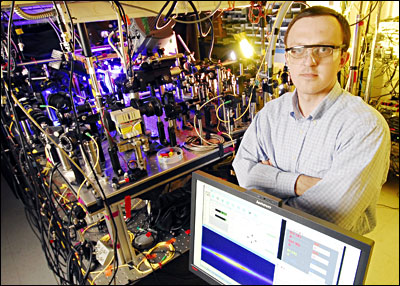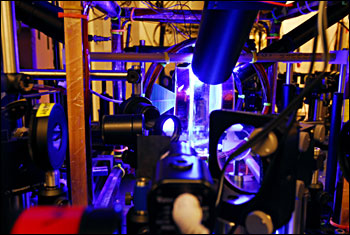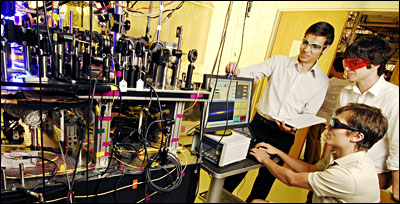
Quantum Signals Converted to Telecom Wavelengths
ATLANTA, Sept. 29, 2010 — Using optically dense, ultracold clouds of rubidium atoms, three key elements needed for quantum information systems have been advanced — including a technique for converting photons carrying quantum data to wavelengths that can be transmitted long distances on optical fiber telecom networks.
The developments move quantum information networks — which securely encode information by entangling photons and atoms — closer to a possible prototype system.
Researchers at the Georgia Institute of Technology reported the findings Sept. 26 in the journal Nature Physics, and in a manuscript submitted for publication in the journal Physical Review Letters.
The advances include:
- Development of an efficient, low-noise system for converting photons carrying quantum information at infrared wavelengths to longer wavelengths suitable for transmission on conventional telecommunications systems. The researchers have demonstrated that the system, believed to be the first of its kind, maintains the entangled information during conversion to telecom wavelengths — and back down to the original infrared wavelengths.
- A significant improvement in the length of time that a quantum repeater — which would be necessary to transmit the information — can maintain the information in memory. The Georgia Tech team reported memory lasting as long as 0.1 second, 30 times longer than previously reported for systems based on cold neutral atoms and approaching the quantum memory goal of at least one second — long enough to transmit the information to the next node in the network.
- An efficient, low-noise system able to convert photons of telecom wavelengths back to infrared wavelengths. Such a system would be necessary for detecting entangled photons transmitted by a quantum information system.

Associate professor Alex Kuzmich with equipment used to study quantum information systems at the Georgia Institute of Technology. (Photos: Gary Meek)
"This is the first system in which such a long memory time has been integrated with the ability to transmit at telecom wavelengths," said Brian Kennedy, a co-author of the Nature Physics paper and a professor in the Georgia Tech School of Physics. "We now have the crucial aspects needed for a quantum repeater."
The conversion technique addresses a long-standing issue facing quantum networks: the wavelengths most useful for creating quantum memory aren't the best for transmitting that information across optical telecommunications networks. Wavelengths of approximately 1.3 µm can be transmitted in optical fiber with the lowest absorption, but the ideal wavelength for storage is 795 nm.
The wavelength conversion takes place in a sophisticated system that uses a cloud of rubidium atoms packed closely together in gaseous form to maximize the likelihood of interaction with photons entering the samples. Two separate laser beams excite the rubidium atoms, which are held in a cigar-shaped magneto-optical trap about 6-mm long. The setup creates a four-wave mixing process that changes the wavelength of photons entering it.
"One photon of infrared light going in becomes one photon of telecom light going out," said Alex Kuzmich, an associate professor in the Georgia Tech School of Physics and another of the paper's co-authors. "To preserve the quantum entanglement, our conversion is done at very high efficiency and with low noise."
By changing the shape, size and density of the rubidium cloud, the researchers have been able to boost efficiency as high as 65 percent. "We learned that the efficiency of the system scales up rather quickly with the size of the trap and the number of atoms," Kuzmich said. "We spent a lot of time to make a really dense optical sample. That dramatically improved the efficiency and was a big factor in making this work."
The four-wave mixing process does not add noise to the signal, which allows the system to maintain the information encoded onto photons by the quantum memory. "There are multiple parameters that affect this process, and we had to work hard to find the optimal set," said Alexander Radnaev, another co-author.

Experimental equipment used to study quantum information systems at Georgia Tech.
Once the photons are converted to telecom wavelengths, they move through optical fiber — and loop back into the magneto-optical trap. They are then converted back to infrared wavelengths for testing to verify that the entanglement has been maintained. That second conversion turns the rubidium cloud into a photon detector that is both efficient and low in noise, Kuzmich said.
Quantum memory is created when laser light is directed into a cloud of rubidium atoms confined in an optical lattice. The energy excites the atoms, and the photons scattered from the atoms carry information about that excitation. In the new Georgia Tech system, these photons carrying quantum information are then fed into the wavelength conversion system.
The research team took two different approaches to extending the quantum memory lifetime, both of which sought to mix the two levels of atoms involved in encoding the quantum information. One approach, described in the Nature Physics paper, used an optical lattice and a two-photon process. The second approach, described in the Physical Review Letters submission, used a magnetic field approach pioneered by researchers at the National Institute of Standards and Technology.
The general purpose of quantum networking is to distribute entangled qubits — two correlated data bits that are either "0" or "1" — over long distances. The qubits would travel as photons across existing optical networks that are part of the existing global telecommunications system.

Researchers Alex Radnaev and Jacob Blumoff (standing) and Yaroslav Dudin collect data for a study of quantum information systems at the Georgia Institute of Technology.
Because of loss in the optical fiber that makes up these networks, repeaters must be installed at regular intervals to boost the signals. For carrying qubits, these repeaters will need quantum memory to receive the photonic signal, store it briefly, and then produce another signal that will carry the data to the next node, and on to its final destination.
"This is another significant step toward improving quantum information systems based on neutral atoms," Kuzmich said. "For quantum repeaters, most of the basic steps have now been made, but achieving the final benchmarks required for an operating system will require intensive optical engineering efforts."
The research team also included Y.O. Dudin, R. Zhao, H.H. Jen, J.Z. Blumoff and S.D. Jenkins. The research was sponsored by the Air Force Office of Scientific Research, the Office of Naval Research and the National Science Foundation.
For more information, visit: www.gatech.edu
Published: September 2010